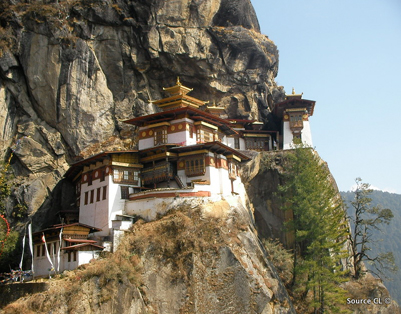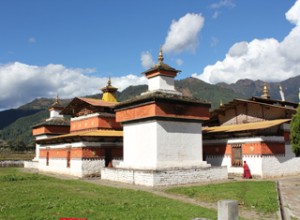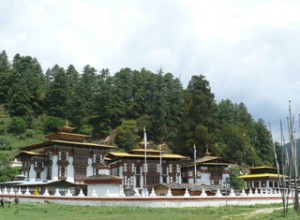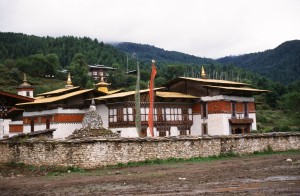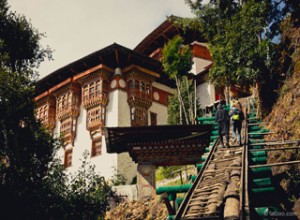Taktsang Monastery, famously known as Tiger Nest Monastery, is located in Paro, Bhutan. The monastery is one of the most venerated places of pilgrimage in the Himalayan. The legend of Taktshang (Tiger’s lair) evolved form 747 AD when Guru Padmasmbhava chose a cave on a sheer rock face to meditate and, assuming a wrathful form, Guru Dorji Drolo, astride a tigress, subdued athe evil spirits n
the locality. Taktshang thus became one of the most important Buddhist monuments in the Himalayan Buddhist world Then name “Taktshang” – Tiger’s Lair – was derived when the people in the locality came across a tigress residing in one of the caves. Legend has it the
tigress actually was Yeshi Tshogyal, a consort of Guru Rinpoche, who has transformed herself into the fearsome animal to subjugate spirits Taktshang clings to the rock towering 800 meters (over 2,600 feet) above the valley, and is located 2,950 meters (9,678 feet) above the sea level. It takes about 2 hours walk to reach the monastery from the road at Ramthangkha, 12 kilometers from Paro town.
The history of this sacred place goes back to the eighth century when Padmasambhava, an extraordinary saint who founded the Mahayana school of Buddhism, visited the site. He assumed the terrifying form of Guru Dorje Drolo and cleansed the place of evil spirits to preserve the integrity of Buddhist teachings.
An account has it that Yeshe Tsogyal transformed herself into a tigress and carried the Guru on herback from Singye Dzong in eastern Bhutan to Taktshang. In a cave there, the Guru then performed meditation and emerged in eight incarnated forms (manifestations).
At Taktshang the Guru revealed the Mandala of Pelchen Dorje Phurpa, and delivered sublime teachings to his disciples. He spent four months in the cave, taming and subjugating the malicious spirits, and concealed profound treasures for the benefit of sentient beings.
Tirst temple was built by Sonam Gyaltshen – a Nyingma Budhist master – probably in 1508 at Taktsang Pelphug. In 1645 the whole site was offered to Zhabdrung Ngawang Namgyel, the founder of the nation state of Bhutan.
It was at Taktshang, during the Tibetan war of 1644/46, that Zhabdrung and his Nyingmapa teacher, Terton Rigdzin Nyingpo, first performed a ritual invoking Padmasambhava and the protective deities. Ihe Zhabdrung instructed Gyalsey Tenzin Rabgye, who subsequently became the fourth temporal ruler of Bhutan, to build the temple of the Eight Manifestations of the Guru there. Ihe work began on the 10th month of the Water Monkey Year (1692) and the two-storied temple was completed in 1694.
Between 1961 and 1965, the monastery was renovated by the 34th Je Khenpo, Shedrup Yoezer. Additions were made in 1861-65 and 1982-83, and then in 1992. On April 19, 1998, Taktshang was damaged in a tragic blaze. It was restored to its original glory by His Majesty Jigme Singye Wangchuck, the Fourth King Of Bhutan.
The story goes that the statue of the Guru was sculptured by Pentsa Deva at Punakha Thangdzong and taken to Taktshang. On arriving at the entrance of the sacred site of Taktshang, the statue is supposed to have spoken: “Do not worry, for someone shall come to carry me to Taktsang!” The statue was miraculously transported and, thereafter, the place is known as the Temple of the Self-Speaking Statue of the Guru.The shrine contains beautiful paintings of the eight manifestations of Guru and his twenty five chief disciples on the rockface (facing face). It also contains the throne used by Gyalse Tenzin Rabgye.
All the sacred objects pertaining to the Eight Manifestaions of Guru were built by famous Niwari artisans Pentsa Deva, Dharma Deva and Dharmashri. The climb to the monsatery takes about 3 hours on a comfortable pace. Frequent trekker and gym enthusiast can complete it in about 2 hours. The total distance walked is about 4 km one way with 700m in elevation gained.

